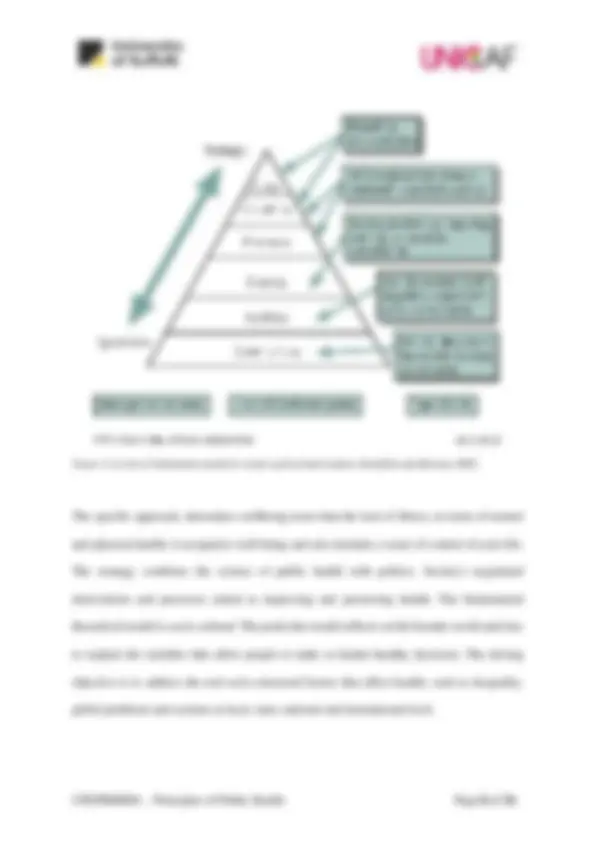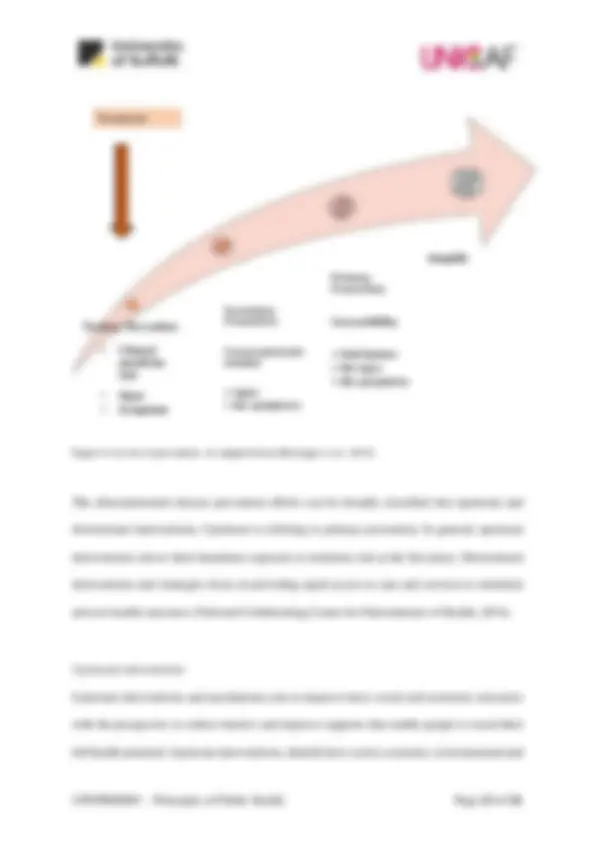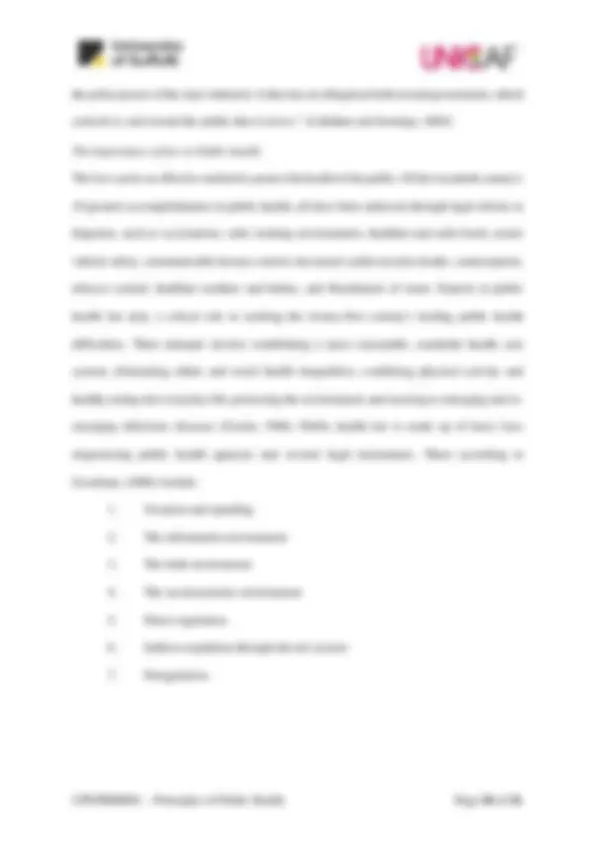


















Study with the several resources on Docsity

Earn points by helping other students or get them with a premium plan


Prepare for your exams
Study with the several resources on Docsity

Earn points to download
Earn points by helping other students or get them with a premium plan
Community
Ask the community for help and clear up your study doubts
Discover the best universities in your country according to Docsity users
Free resources
Download our free guides on studying techniques, anxiety management strategies, and thesis advice from Docsity tutors
A comprehensive introduction to the principles of public health practice, covering its history, contemporary principles, and ethical considerations. It explores the role of prevention, promotion, and protection of health, highlighting the importance of policy and law in public health interventions. The document also delves into the multidisciplinary nature of public health, outlining key areas of professional training and the importance of quality and efficacy in public health interventions. It further examines the concept of sustainable health and the challenges of addressing health inequalities.
Typology: Lecture notes
1 / 24

This page cannot be seen from the preview
Don't miss anything!

















Learning Objectives
disease. This resulted in a development path that converged with the continuous development of science (Perdiguero et al. , 2001).
Sanitation and Environmental health Disease controls and health promotion through hygiene was among the first matters addressed by public health practice. Some examples of how public health worked by environmental interventions to prevent infectious disease include ancient Greeks’ and Romans efforts to establish public hygiene measures. For example, ancient Greeks stated the Hippocratic idea, which includes the concept of “healthy mind in a healthy body”. The three main concepts stated by Hippocrates were health promotion, interventions on trauma care and mental care. (Kleisiaris, Sfakianakis and Papathanasiou, 2014). The Public Health Act of 1848 was created almost two millennia later in United Kingdom (Fee and Brown, 2005). This established a regional health department and put sanitation duties in the hands of municipalities. In addition, the identification of the value of sanitation in decreasing the spread of disease and promoting a healthy environment led to relevant governmental initiatives. For example, the government of the UK passed the Public Health Act, creating a Central Health Board and corporate districts responsible for drainage and water supply to distinct regions, in 1948. Later on, the Nixon Administration set up the Environmental Protection Agency in 1970 in United States that protects people's health by protecting the environment.
Influenza and Polio Pandemics Pandemics are epidemics and disease outbreaks that spread throughout the world and affect multi-continent populations. Over both the distant past and recent history, pneumonia, or flu, has triggered many pandemics. Spain's flu infected 500 million people worldwide nearly a century ago, including remote Pacific Islands and the Arctic, killing 20 to 50 million people.
In London, cholera, a deadly intestinal infection, became widespread during the early 1800s, causing death within hours of the first symptoms to hundreds of thousands of people. At the time most of the people believed that cholera was caused by bad breath from rotting organic matter. In 1854, John Snow's documented cholera outbreak in the second edition of "On the Cholera Communication Mode". Snow was skeptical of the miasma theory of infection, and he believed that sewage dumped into rivers and drains near town wells contaminated the water supplies and cause cholera outbreaks.
John Snow was “The father of Epidemiology” John Snow was a British Physician, with his role in determining the cause of a cholera outbreak in 1854, he is also recognized one of the fathers of modern epidemiology. His research showed a mode of transmission of disease that strongly defied the prevailing theory of miasma. While being ignored at the time, his research would later be accepted as evidence of the infection germ hypothesis that would become popular in the years following Snow's death. Snow was also a leading proponent of medicine for both anesthesia and hygienic procedures. He also designed the mask for anesthesia implementation (Past Medical history, 2019).
Figure 1 : The founding father of epidemiology.
Similarly, poliomyelitis was a widespread and widely feared disorder that caused severe illness in thousands of people every year, such as paralysis and death. After it was launched in 1955, thousands of people signed up to receive the polio vaccine. In 1988, leading to outbreaks in over 125 nations, an effort to eliminate polio was initiated. Polio persists in just a few countries today. Likewise, Human Immunodeficiency Virus, or HIV, spread exponentially throughout
Natural disasters and threats created by humans Public Health is also involved in preparedness and response to disasters, both for human and natural-made disasters. Biological technology has been used to kill humans and animals for decades. The invading Tartar armies used plague as a weapon of war during the siege of Kaffa in the 14th century AD by tossing plague-infected corpses into the enemy's settlement. Colonial acts ended the first phase of the European Black Death (or plague). Public health professionals were on the field at the World Trade Center and the Pentagon in the immediate wake of the terrorist attacks on September 11, 2001, conducting surveillance to detect disease outbreaks or other potential health problems arising from the attacks. The wellbeing of first responders, city residents, and environmental factors was closely monitored by public health staff to identify health risks during the recovery after the attack. Public health personnel and other disaster relief organizations diligently received emergency services during Hurricane Katrina in 2005. Teams are deployed to monitor people who fled to shelters and other places of safety after the storm for illness and injury.
Organizational foundations of historical and current Public health practice A successful public health system is a corporation of different associates, such as, education, non-profit health organizations, medical associations. In addition, the decision to focus on policy is practical: taking a very broad view of the system of public health, which requires a number of participants in all areas of society. Generally, without any formalized structure, partnerships, or responsibilities, the system becomes relatively immune to generalization, and as we will see, the government system itself is sufficiently complex all by itself. (Goldsteen, Goldsteen and Graham ,2010)
Figure 2 : Levels of information needed to create a policy/intervention (AbouZahr and Boerma, 2005)
The specific approach, determines wellbeing more than the lack of illness, in terms of mental and physical health, it recognizes well-being and also includes a sense of control of your life. The strategy combines the science of public health with politics. Society's negotiated intervention and processes aimed at improving and preserving health. The fundamental theoretical model is socio-cultural. The particular model reflects on the broader world and tries to explain the variables that allow people to make or hinder healthy decisions. The driving objective is to address the real socio-structural factors that affect health, such as inequality, global problems and systems at local, state, national and international level.
Figure 3 : Essential Public health services (CDC, 2018a).
This principle guarantees that in evaluating the quality of public health services, commitments by all individuals to the health and well-being of the city or government are remembered. There are 10 essential public health services as figure 4 shows. The three essentials however are Policy, Assessment and Assurance (Centers of Disease Control and Prevention, 2018b).
Quality and Efficacy in Public health practice The key objective of any action in public health must be to change the health of communities, ultimately by decreasing the damaging impacts of morbid incidents, but mainly by decreasing the occurrence rates of these incidents (Bowling, 2005). According to Institute of Health Equity (2019), measuring and tracking is an essential component of public health practices aiming at improving results, and thus, improve quality, and reduce inequalities. Such measures assist
public health professionals to prioritize action where there is need the most and assess relevant intervention strategies (Institute of health equity, 2019). The Marmot Indicators, include measures on life expectancy, health life expectancy, educational rates, employment rates, life satisfaction and etc. (Institute of health equity, 2019). Another, no less significant element, is efficiency. For public health interventions to be efficient they need to be applied to communities, even if applicable to individuals. This view in assessing public health interventions takes us nearer to the traditions of assessing social intervention programs and policies in particular (Bowling, 2005).
Disease prevention Public Health is based on disease prevention and promotion of wellness rather than illness diagnosis and treatment. Public Health has historically focused on reducing exposure to disease-related hazards. Expanding emphasis is placed on downstream strategies that minimize the danger instead of simply preventing or reducing exposure. This kind of public health interventions often take place at all level of government, from the state to local communities (Centers for Disease Control and Prevention, 2017).
Primary prevention Primary prevention involves activities designed primarily to avoid the development of illness. Examples involve the implementation of law to prohibit or regulate the use of dangerous products, to mandate healthy and safe practices (e.g. use of safety belts and bike helmets) on safe and healthy habits (e.g. eating well, frequently exercising, not smoking) and immunization against communicable diseases (Vu, Moser and Dvorak, 2015).
Treatment
Tertiary Prevention
Figure 4: Levels of prevention. As adapted from (Reisinger et al ., 2012)
The aforementioned disease prevention efforts can be broadly classified into upstream and downstream interventions. Upstream is referring to primary prevention. In general, upstream interventions aim to limit hazardous exposure to minimize risk at the first place. Downstream interventions and strategies focus on providing equal access to care and services to minimize adverse health outcomes (National Collaborating Centre for Determinants of Health, 2014).
Upstream interventions Upstream interventions and mechanisms aim to improve basic social and economic structures with the prospective to reduce barriers and improve supports that enable people to reach their full health potential. Upstream interventions, identify how social, economic, environmental and
other determinants can affect organisms and finally cause a disease. These factor have impact on each person’s behavior, illness and health condition (Martz, 2018).
Downstream interventions Downstream intervention and strategies refer to secondary and tertiary prevention. In essence, downstream interventions aim to identify health issues at an initial stage to lower the risk for disease progression or the transmission of the disease to others. Downstream interventions also include therapeutic efforts that aim to maintain the quality of life of people suffering from an acute illness or injury (National Collaborating Centre for Determinants of Health, 2014).
Figure 5 : Upstream and Downstream interventions
Sustainable health and contemporary health The concurrent worsening of public health and the condition of the environment are partially related to the insufficient convergence of the national, regional and global aspects of health promotion and sustainability. As a result of society's misuse of natural resource extraction and over-exploitation of environmental services such as carbon sequestration and conservation, some health and sustainability challenges arise. In other words, the increased escalation of agriculture and food production triggers some public health and environmental issues. Shared root causes, however, are no guarantee that the aspects of health and development will be translated into reports or policies for national, regional and international government (SDS Consulting, 2005).
Deforestation of tropical rain forests in Malaysia acts as an example. Similarly, Indonesia’s palm oil industry for fuel and cooking oil can be seen as an instance of the complex chain of consequence that follows particular actions. The goal has often been to address health issues (palm oil is free of trans fat) and to provide healthy food oil supplies, but the negative effects include high saturated fat in palm oil, soil exhaustion, soil erosion, and biodiversity loss that affect public health (Kjærgård, Land and Pedersen, 2014).
Health inequalities Health inequalities define the unfair distribution of health or its determinants across the nation and specifically across separate populations. Social inequalities are not spontaneous but they pursue a social gradient. (Marmot, 2010). According to Gehlert et al ., (2008) and Brownson, Seiler and Eyler, (2010) the relationship between social gradient and disease is getting stronger. Beginning on top with ethnicity, underdeveloped community and discrimination lead to isolation and lastly to cell survival and cancer.
Despite global efforts, the reduction of health inequalities remains an important target. In 2000 the National institute on Minority Health and Health Disparities was established in United States. Its g development of the National institute on Minority Health and Health Disparities led to the establishment of various other organizations aiming to address health inequalities (National Institute on Minority Health and Health Disparities, 2017).
Political and ethical issues relating to contemporary Public health practices Since the foundation of the republic, when the main threats to health and safety were epidemic disease, the law has played a crucial part in public health. Law generates government organizations, appoints their task, authorizes them, and limits their activities to safeguard a sphere of liberty described in the constitution. Consequently, the law has always been essential to public health. For example, taxes on cigarettes seem to be the most cost-effective method of reducing tobacco smoking, especially for young people and people with low incomes. An increase in taxes that increases the price of tobacco by 10% decreases the production of cigarettes in high-income communities by around 4% and in low- and middle-income countries by about 5%. (WHO, 2019) Just as these old and new threats teach us the significance of powerful public health infrastructure, they also remind us of the need for adequate forces of public health. Of course, public health law is not just about authority, it is also about restraint. Public health practitioners need to behave with powerful scientific evidence and fairness and tolerance in order to be efficient (Bowling, 2005). Practice and ethics in public health are closely linked to public health law, which influences the state's ability to protect the health of the public and limits that power in the form of individual rights and structural restrictions. As Daniel Callahan and Bruce Jennings have noted, “Public health is one of the few professions that has, in many matters, legal power–in particular,
Example of an implemented policy An example of how policies implement in health promotion and disease prevention is MPOWER. In 2007, the WHO implemented a realistic and cost-effective way of increasing the adoption of the WHO framework convention on tobacco control key demand management provisions:
MPOWER. Each assessment of MPOWER refers to at least one aspect of the Tobacco Control Policy Convention of the WHO. (WHO, 2019)
The MPOWER measures are: Monitor the use of tobacco and creation of prevention policies Protect individuals from smoking Offer them help to quit smoking Warn (educate) them about the dangers of smoking in health Enforce bans on tobacco promotion Raise taxes on tobacco products.
References AbouZahr, C. and Boerma, T. (2005) ‘Health information systems: the foundations of public health.’, Bulletin of the World Health Organization, 83, pp.578-583.
Acheson, D. and Great Britain (1988) Public health in England: the report of the Committee of Inquiry into the Future Development of the Public Health Function. London: The Stationery Office.
Andresen, E., and Bouldin, E. D. (1st ed) (2010) Public Health Foundations : Concepts and Practices. California: John Wiley & Sons.United States.
Bowling, A. (2005) Measuring Health: A Review of Quality of Life Measurement Scales. Maidenhead: Open University Press.
Brownson, R. C., Seiler, R. and Eyler, A. A., (2010) Peer Reviewed: Measuring the impact of public health policy’, Preventing Chronic Disease , 7(4), pp. 1–7.
Callahan, D. and Jennings, B. (2002) ‘Ethics and Public Health: Forging a Strong Relationship’, American Journal of Public Health, 92(2), pp. 169-176.
Centers for Disease Control and Prevention (2017) Picture of America: Our Health and Environment. Available at: https://www.cdc.gov/pictureofamerica/pdfs/picture_of_america _prevention.pdf (Accessed: 20 November 2019).